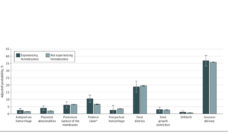The 2008 global financial crisis that ballooned on the back of risky lending practices burst the US housing bubble. Mortgage-backed securities failed, home values fell, and an unprecedented wave of homeowners defaulted on their mortgages. The resulting foreclosure crisis increased stress and reduced wealth, diminishing public health in complex ways. Individuals facing foreclosure and eviction were more likely to die by suicide. Residents of neighborhoods with high foreclosure rates were more likely experience depression, chronic health problems, and, in cities, higher rates of blood pressure.
A little-known health impact of the foreclosure crisis was its effect on intimate partner violence. Intimate partner violence is a problem rooted not only in families and romantic relationships but also in neighborhoods. Intimate partner violence thrives in neighborhoods that lack social connectedness and responsibility. This social support web exists in communities where neighbors watch out for each other and provide support when something goes awry. And it is bolstered by institutional resources, such as shelters or legal aid, which help individuals experiencing violence leave their abusers.
The foreclosure crisis fractured these supports that help to protect residents from intimate partner violence and stop it when it occurs. Neighborhood turnover increased, leading to feelings of social disconnectedness. Neighbors with previously good social relationships saw their networks dissolve over resentment and shame surrounding foreclosures. Businesses failed and housing investment dried up. In some places, violent and property crime rose and disorder flourished. These changes added fuel to the underlying mechanisms within neighborhoods related to intimate partner violence. Many communities experienced sudden and drastic decreases in social and economic resources critical to preventing intimate partner violence.
In our study, we show that intimate partner violence was a consequence of the drastic changes experienced in neighborhoods during the foreclosure crisis. Examining intimate partner violence in three cities in the Phoenix, Arizona metropolitan area – Glendale, Mesa, and Surprise – we found that neighborhoods with more foreclosures had higher rates of intimate partner violence during the crisis, particularly its latter stage between 2010 and 2011. Disadvantaged neighborhoods, particularly those experiencing economic disadvantage and slower housing market recovery, were more prone to intimate partner violence, indicating that foreclosures may have compounded the strain of living on the economic margins.
Overall, our study underscores that large-scale societal crises can have unexpected health consequences, such as increases in intimate partner violence, which has implications for the current situation. The global coronavirus pandemic, like the Great Recession and foreclosure crisis, has the potential to crack the social and institutional foundations of communities. The longstanding shortages in affordable housing mean that we are on the cusp of a neighborhood upheaval similar to, and perhaps more drastic than, what occurred during the Great Recession.
As the eviction moratorium expires, renters and the financially vulnerable will be displaced. Social connectedness and responsibility in neighborhoods, the very conditions that protect against intimate partner violence, may quickly diminish as families are displaced and homelessness spikes. Evictions may usher in the next US housing crisis, sparking a secondary health emergency in the form of intimate partner violence.
Photo via Getty Images
















